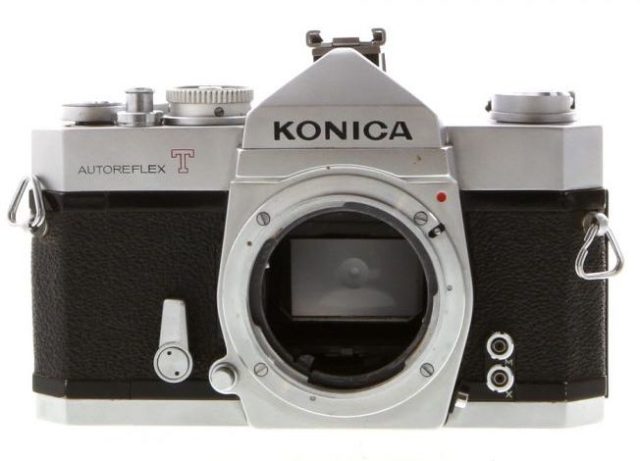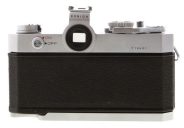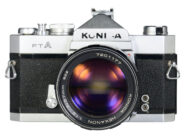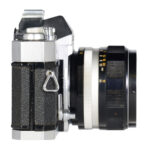Announced
Production status
System
Konica AR system cameras
- Konica Auto-Reflex
- Konica Auto-Reflex P
- Konica Autoreflex A
- Konica Autoreflex A1000
- Konica Autoreflex A2
- Konica Autoreflex A3
- Konica Autoreflex T
- Konica Autoreflex T2
- Konica Autoreflex T3
- Konica Autoreflex T3N
- Konica Autoreflex T4
- Konica Autoreflex TC
- Konica FC-1
- Konica FP-1 PROGRAM
- Konica FS-1
- Konica FT-1 MOTOR
- Konica TC-X
Konica Autoreflex T
aka Konica FTA
35mm MF film SLR camera • Discontinued
Specification
| Format: | |
| 35mm full frame | |
Film type: | 135 cartridge-loaded film |
| Konica AR [40.5mm] | |
| Shutter: | |
Type: | Focal-plane |
Model: | Mechanical |
Speeds: | 1 - 1/1000 + B |
| Exposure: | |
Exposure metering: | Through-the-lens (TTL), open-aperture |
Exposure modes: | Manual |
| Physical characteristics: | |
Weight: | 965g |
Dimensions: | 146x95x89mm |
Manufacturer description #1
Announcing a new generation of SLRs:
KONICA INVENTS THE FIRST PROFESSIONAL SLR WITH TOTAL AUTOMATION
View. Focus. Shoot. And get the picture - perfectly exposed. Because with Konica's new Autoreflex-T, you never have to touch an aperture ring or match a needle - unless you want to. The Autoreflex-T's exposure system automatically sets lens apertures for you.
Our secret: the first truly automatic transfer system.
It reads the light coming through the lens, and transfers that reading to the lens. So the lens - wide open while you view and focus - closes down at the instant of exposure to exactly the aperture transferred from the meter, then re-opens instantly.
That makes our Autoreflex-T Hexanon AR lenses truly, totally automatic.
Eleven automatic lenses - and then some.
The Autoreflex-T gives you eleven automatic Hexanon lenses to shoot through: three wide-angles (including a sensational 21mm f/4 Hexanon 90° ultra-wide); three standard lenses (f/1.8, f/1.4 and an ultra-fast f/1.2); four telephotos (from 85mm f/1.8 to 200mm f/3.5); and an 80-200mm f/3.5 zoom.
But that's just the beginning. The Konica system also includes telephotos from 400mm to 2000mm, plus 70-230mm and 58-400mm zooms; adapters for hundreds of other lenses; and a range of accessories for every application.
A control center at your eye-level.
The viewfinder does more than just help you frame and focus. It's a complete control center.
The meter scale gives you a running check of what f-stop you're shooting at (with auto-exposure). If you want to expose manually (or if you're shooting with our pre-set lenses, other makers' lenses, or through extension bellows or microscope), there's a match-needle mark that lets you set your exposure instantly.
The red under-exposure indicator automatically shifts as you change auto lenses showing you the maximum aperture of the lens actually in use. And an illuminated "M" tells you when you've switched from auto to manual operation.
Center-weighted dual CdS cells.
Because the Autoreflex-T's exposure system reads through the lens - any lens - it always reads exactly what the lens sees.
But with a difference: the twin CdS cells of the Autoreflex-T take center-weighted readings - to give prime emphasis to the most important areas of your subject - yet take all areas of your picture into account.
Even our shutter has unique advantages. Unlike others, the Autoreflex-T's all-metal focal-plane shutter synchronizes with electronic flash at all speeds to 1/125 (and to 1/1000 with standard flashbulbs).
A companion in the System.
Only one camera comes close to matching the Autoreflex-T: the Konica Auto-Reflex. It has the same automatic aperture control, with CdS cell alongside the lens. And it's the only camera that lets you switch from full-frame to half-frame operation.
If you're serious about photography, you will own one of these cameras - ultimately. Why not now?
Manufacturer description #2
These professional SLRs set exposures without "needle-matching"
They're all Konica Autoreflex. They let you frame, focus and shoot - and get perfectly exposed pictures - without matching needles by twisting aperture rings (unless you want to).
Significantly, all are professional 35mm SLRs. Which means they're cameras around which a system has been built. Included are Auto-Hexanon lenses (from 21mm to an 80/200mm zoom), preset Hexanon lenses (to 2000mm), plus the complete array of professional accessories you demand in a professional system.
Konica also has a most significant differences: it's built around center-weighted, through-the-lens meters which read the light entering any Auto-Hexanon lens and transfer that reading to the diaphragm - automatically!
So the lens - wide open while you view and focus - closes down at the instant of exposure to exactly the f/stop transferred from the meter.
We call this Automatic Exposure Control (AEC). Only Konica Autoreflex has it. Think of that before you invest in yesterday's "match-needle" SLR.
Manufacturer description #3
Camera Type: Precision, professional 35mm SLR with metal focal plane shutter and fully automatic CdS Through-The-Lens (TTL) exposure meter operation.
Picture Size: 24 x 36mm.
Film: Standard 35mm cartridges, 20 or 36 exposures.
Lens Mount: KONICA bayonet mount Type II, 47mm diameter, 40.5mm flange back.
Diaphragm Action: Fully automatic diaphragm. Automatic EE lenses reopen to full aperture for focusing and exposure metering. Manual aperture control and Depth-of-Field preview button provided.
Shutter: Hi-Synchro Metal Copal Square S. "B" (Bulb), 1 to 1/500 second, in even 1:2 progression. Shutter speed dial on top of camera. Shutter Release locks when Meter Switch is in locked position. X - synchro for electronic flash to 1/125 second; M - synchro for flash-bulbs to 1/500 second
Viewfinder: Eye-level pentaprism. Extremely bright. Has central Micro Diaprism area surrounded by plain ground glass circle. Balance is fine, almost invisible fresnel ground glass area. Meter needle, f/stops, shutter speed, battery check, index point for stopped-down metering, under- and overexposure marks, automatic and non-automatic mode signal visible outside focusing/viewing area.
Mirror Action: Vertical travel, instant return.
Exposure Metering: Center weighted dual CdS, Through-The-Lens (TTL). KONICA Hexanon AR lenses stop down automatically after shutter release is depressed. No need to match needle to a mark. Focusing, metering at full lens aperture. Meter system coupled to film and shutter speeds. With manual and preset lens operation, lens is stopped-down or Shutter Speed Dial turned until meter needle reaches index mark (opposite f/1.4) in Viewfinder. Battery check visible in Viewfinder.
EE Coupling Range: EV 1.5 (f/1.2 with 1/2 sec.) to EV 18 (f/16 with 1/1000 sec.) at ASA 100 for f/1.2 lens.
Film Sensitivity Range: ASA 25 to 1600 (DIN 15 to 33).
Film Wind: Single stroke lever, cocks shutter and transports film. 162 deg. stroke. In operation, lever stops 30 deg. from body position for fast shooting without removing eye from camera.
Film Counter: Resets self to "Start" automatically as camera back is opened. Indicates number of shots exposed. Dial is under glass, protected against dust and dirt.
Film Rewind: Film rewind crank. Rewind Button in base of camera remains depressed during rewinding.
From the editor
The weight and dimensions are indicated for the camera body with the Konica Hexanon AR 52mm F/1.8 lens mounted.







